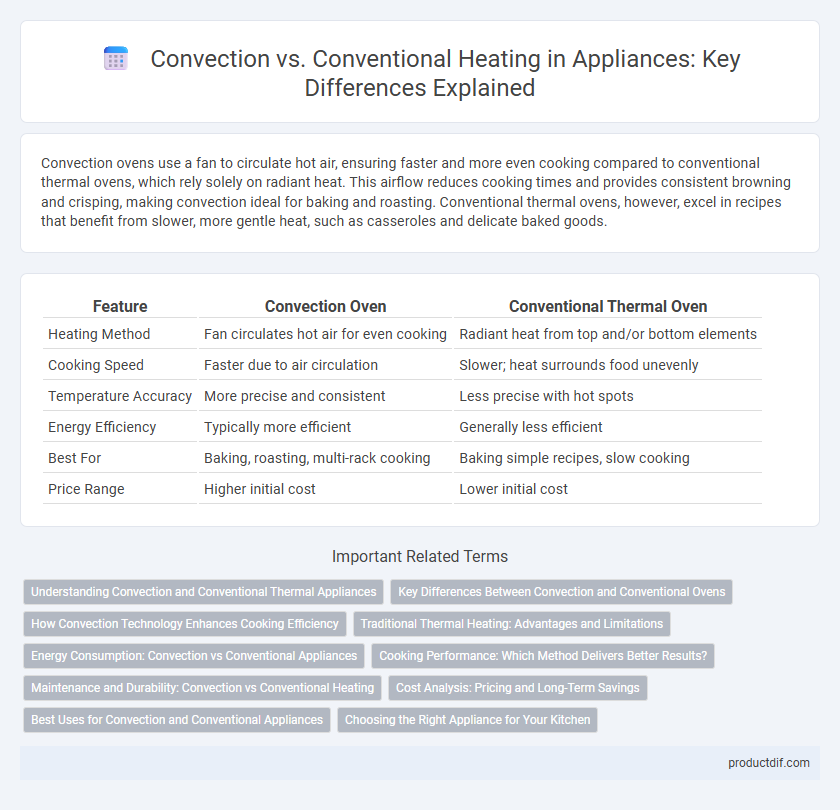Convection ovens use a fan to circulate hot air, ensuring faster and more even cooking compared to conventional thermal ovens, which rely solely on radiant heat. This airflow reduces cooking times and provides consistent browning and crisping, making convection ideal for baking and roasting. Conventional thermal ovens, however, excel in recipes that benefit from slower, more gentle heat, such as casseroles and delicate baked goods.
Table of Comparison
| Feature | Convection Oven | Conventional Thermal Oven |
|---|---|---|
| Heating Method | Fan circulates hot air for even cooking | Radiant heat from top and/or bottom elements |
| Cooking Speed | Faster due to air circulation | Slower; heat surrounds food unevenly |
| Temperature Accuracy | More precise and consistent | Less precise with hot spots |
| Energy Efficiency | Typically more efficient | Generally less efficient |
| Best For | Baking, roasting, multi-rack cooking | Baking simple recipes, slow cooking |
| Price Range | Higher initial cost | Lower initial cost |
Understanding Convection and Conventional Thermal Appliances
Convection appliances use fans to circulate hot air evenly, resulting in faster and more uniform cooking compared to conventional thermal appliances, which rely on radiant heat from elements. Conventional thermal devices heat food primarily through direct exposure to heat sources, often causing uneven temperature distribution. Understanding these operational differences helps consumers choose appliances based on cooking speed, energy efficiency, and food texture preferences.
Key Differences Between Convection and Conventional Ovens
Convection ovens use a fan to circulate hot air, ensuring even cooking and faster baking times compared to conventional ovens, which rely on stationary heat from top and bottom heating elements. The consistent airflow in convection ovens reduces hot spots and allows for better browning and crisping of foods, making them ideal for roasting and baking delicate pastries. Conventional ovens maintain a stable temperature without air movement, which can result in longer cooking times and less uniform heat distribution.
How Convection Technology Enhances Cooking Efficiency
Convection technology enhances cooking efficiency by using a fan to circulate hot air evenly around food, reducing cooking time and ensuring uniform heat distribution. This method prevents hot spots and allows for lower cooking temperatures compared to conventional thermal ovens, which rely on radiant heat from heating elements. As a result, convection ovens deliver faster, more energy-efficient cooking with improved texture and browning.
Traditional Thermal Heating: Advantages and Limitations
Traditional thermal heating in appliances offers consistent, direct heat transfer, ensuring uniform cooking results for baked goods and casseroles. Its straightforward design often results in lower purchase costs and simpler maintenance compared to convection models. However, limitations include slower cooking times and uneven heat distribution, which can lead to hotspots and less efficient energy use.
Energy Consumption: Convection vs Conventional Appliances
Convection appliances utilize a fan to circulate hot air, resulting in faster and more even cooking, which typically reduces energy consumption compared to conventional appliances that rely on radiant heat. Conventional thermal appliances often require longer cooking times and higher temperatures, leading to increased energy usage. Energy efficiency ratings consistently show convection models outperforming conventional ones, making them a cost-effective choice for reducing electricity bills.
Cooking Performance: Which Method Delivers Better Results?
Convection ovens use a fan to circulate hot air, ensuring even cooking and reducing cooking time compared to conventional thermal ovens, which rely on radiant heat from top and bottom elements. This consistent airflow results in better browning, crisping, and more uniform heat distribution, enhancing the overall cooking performance. For baking, roasting, and multi-rack cooking, convection ovens typically deliver superior and more reliable results than conventional thermal methods.
Maintenance and Durability: Convection vs Conventional Heating
Convection ovens feature fans that distribute heat evenly, reducing hot spots and wear on heating elements, which typically leads to lower maintenance requirements and extended durability compared to conventional ovens. Conventional ovens rely on static heating elements that can develop hotspots, causing uneven wear and potentially more frequent repairs or replacements. The consistent airflow in convection ovens also helps prevent moisture buildup, reducing the risk of corrosion and ensuring longer appliance lifespan.
Cost Analysis: Pricing and Long-Term Savings
Convection ovens typically have a higher upfront cost compared to conventional thermal ovens due to advanced fan technology that ensures even heat distribution. Long-term savings are realized through reduced cooking times and lower energy consumption, making convection ovens more cost-efficient over time. Conventional ovens may have lower initial prices but tend to consume more electricity, increasing operational costs and diminishing overall savings.
Best Uses for Convection and Conventional Appliances
Convection appliances excel in baking and roasting by circulating hot air for even cooking and faster results, ideal for pastries, cookies, and meats. Conventional appliances are best suited for traditional recipes requiring slower, more consistent heat, such as casseroles and bread, ensuring thorough cooking without drying. Choosing between convection and conventional depends on the food type and cooking speed desired.
Choosing the Right Appliance for Your Kitchen
Convection ovens use a fan to circulate hot air evenly, promoting faster and more uniform cooking, which is ideal for baking and roasting. Conventional thermal ovens rely on radiant heat from the top and bottom elements, offering traditional cooking methods suitable for recipes that require slow and gentle heating. Choosing the right appliance depends on your cooking style, with convection ovens providing efficiency and consistency, while conventional ovens excel in maintaining classic cooking textures.
Convection vs Conventional Thermal Infographic

 productdif.com
productdif.com